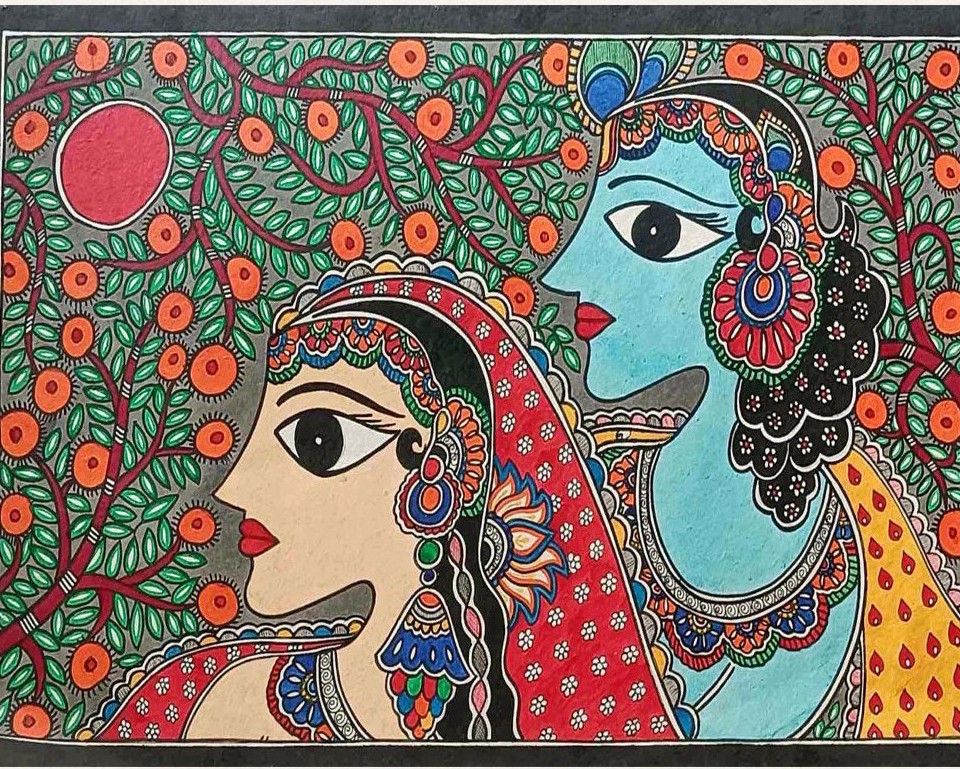The Beautiful Tradition of Madhubani: Art That Tells Tales

Madhubani art, also called Mithila painting, is a special and very old kind of art from Bihar, India. It is famous for its beautiful patterns, bright colors, and the stories it tells. This art shows the creativity and culture of people from the Mithila region. Let’s explore how Madhubani art began and became so loved all over the world.
How It All Started
The story of Madhubani art is linked to an old Indian epic, the Ramayana. Long ago, King Janaka of Mithila wanted to celebrate his daughter Sita’s wedding to Lord Rama. He asked artists to decorate the walls of his palace with beautiful paintings. This was the beginning of Madhubani art, and since then, the tradition has been passed down from one generation to the next, mostly by women.
In the past, people painted Madhubani art on the walls and floors of their homes using natural colors. These paintings were made during festivals, weddings, and other special occasions to bring happiness, luck, and blessings. Over time, the art grew to show scenes from nature, gods, and everyday life.
How Madhubani Art is Made
Madhubani art is special because of its detailed designs and unique ways of painting. There are three main styles:
- Bharni Style: This style is full of bright colors and often shows gods and goddesses from stories. It was mostly done by Brahmin women.
- Katchni Style: This style uses thin lines and fine details. It is usually done in black and white or with just a few colors.
- Godna Style: This style looks like tattoos and uses patterns made with dots and lines.
Other styles include Kohbar, which is made for weddings and shows love and blessings. The artists use simple tools like sticks and brushes made from bamboo. They make colors from things like turmeric, flowers, and rice paste. They also make sure every part of the painting is filled with patterns like flowers, animals, or shapes.
Why Madhubani Art is Important
Madhubani art is not just about painting; it tells stories and shows what’s important to the people of Mithila. The paintings often have:
- Gods and Goddesses: Like Krishna, Rama, Shiva, and Durga.
- Nature: Things like trees, animals, and the Sun to show life and beauty.
- Special Moments: Scenes from festivals, weddings, and daily life.
These paintings bring good luck and blessings. For example, during weddings, people make Kohbar paintings to wish for love and happiness.
How Madhubani Art Changed
For many years, Madhubani art was only made on walls and floors in villages. But in the 1960s, a terrible famine hit Bihar. To help the artists earn money, they started painting on paper, cloth, and canvas. This helped Madhubani art reach people outside the villages and even outside India.
Many people and organizations worked hard to make Madhubani art famous. The All India Handicrafts Board and people like Pupul Jayakar helped the artists show their work in big exhibitions. Soon, people all over the world began to love Madhubani art.
Famous Artists of Madhubani Art
Madhubani art became famous because of the amazing work of women artists. Some of the most well-known artists are:
- Jagadamba Devi: The first Madhubani artist to win the Padma Shri award.
- Sita Devi: Her paintings made Madhubani art popular around the world.
- Baua Devi, Mahasundari Devi, and Ganga Devi: These artists kept the tradition alive and made it even better.
In 2007, Madhubani art got a special award called the Geographical Indication (GI) tag. This means it is recognized as an important part of Indian culture.
Madhubani Art Today
Today, Madhubani art is not just for walls and floors. It is used on clothes, bags, and home decorations. Many artists also use it to talk about important topics like saving trees, helping the environment, and treating everyone equally.
You can even see Madhubani paintings on public walls in cities. They make the streets look beautiful and share important messages with people.
Challenges and Hope for the Future
Even though Madhubani art is famous, there are some problems. Many fake paintings are sold, which makes it hard for real artists to earn money. Also, some young people are not learning this art because they want other jobs.
To help, many groups are teaching Madhubani art to young artists and helping them sell their work. They are also saving old designs and sharing them online so more people can learn about this wonderful tradition.
Madhubani art is more than just pretty pictures. It is a part of India’s history and culture. It shows the creativity and love of the women who have kept this tradition alive for hundreds of years. By supporting Madhubani art, we can keep this beautiful tradition alive for many more generations.